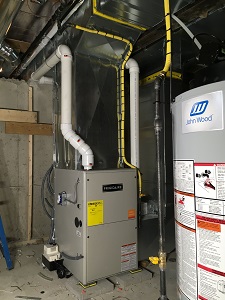Cost To Install A Propane Furnace
Last Updated on December 27, 2023
Written by CPA Alec Pow | Content Reviewed by ![]() CFA Alexander Popinker
CFA Alexander Popinker
Propane is one of the most popular and versatile fuels used for heating domestic and industrial spaces throughout the world. It ensures maximum comfort and efficiency for heating domestic and industrial spaces. Practically, the use of propane is similar in terms of comfort to methane gas from the network, propane being considered the best heating solution for areas that are not connected to the natural gas network.
Lowering energy costs and protecting the environment are the main advantages of using propane in both business and home. When the gas network is inaccessible, you want energy independence and to achieve a long-term decrease in your budget for bills, the solution is a propane furnace.
How Much Does It Cost To Install A Propane Furnace?
There are different propane furnaces on the market, so the cost of installing one will depend on its type, the level of efficiency, accessories, brand, heat output, the contractor you hire, and others. Also, when choosing a propane furnace model, you should pay attention to the annual fuel utilization efficiency (AFUE).
In the table below you will find the average costs for installing a propane furnace.
| Item | Cost |
|---|---|
| Furnace and parts | $700-$1,100 |
| Removal and disposal of old equipment | $900-$2,200 |
| Tank installation (If leased) | $110 contract, $5 per foot gas line installation, $120 meter, and $80 for 1.1 yards for concrete pad when needed |
| Labor | $1,200-$2,500 |
| Total Costs | $3,000-$6,400 |
What are the extra costs?
In case your propane furnace is equipped with an air-blowing system, you may want to also install a HEPA air filter and humidifier. These will increase the costs by around $850. Though, it is worth the investment because the air will be cleaner to breathe and your home will be more comfortable.
You might also like our articles on the cost of a propane tank, furnace ignitor replacement, or chimney sweeping.
Converting a gas furnace to a propane furnace
It is a common industry practice to convert a natural furnace into a propane furnace. This is not a DIY project and the conversion work is done by qualified HVAC technicians using a conversion kit. This job involves installing “spoiler screws” in the burners, adding a low gas pressure switch, and replacing the natural gas burner orifices with orifices that are calibrated for propane.
Benefits of propane furnace
Convenience – compared to the use of solid fuel like wood, pellets, coal, etc., there is no need to store the fuel. By comparison, wood requires cutting, long storage for drying, daily feeding of the boiler, periodic cleaning of ash, etc.
The flexibility to switch from a propane-set heating furnace to gas is a major advantage in connecting homes built in residential areas that are not yet connected to the natural gas pipeline. With a minor change, namely the change of the nozzles used in the furnace, it will switch to a gas supply without additional investments.
The cost of propane is close to that of wood (up to 20% higher) and significantly less than electricity. This fact recommends it once again as a good option for heating, where it is not possible to connect to the natural gas network.
Performance – propane furnaces offer the best AFUE (annual fuel utilization efficiency) levels. Actually, most of the models offer AFUE ratings of 98%. These heating units are equipped with a variable speed blower and a multi-stage burner system, so your home will be heated comfortably and steadily.
Important things to consider
 When installing a propane furnace, you will need proper permits from the local authorities. In general, your HVAC contractor will be responsible for obtaining these permissions.
When installing a propane furnace, you will need proper permits from the local authorities. In general, your HVAC contractor will be responsible for obtaining these permissions.
An inspection of the new insulation, installation, and ductwork will be necessary.
According to many people, it may be more expensive to maintain a propane furnace and purchase propane than traditional oil or natural gas.
How often should a propane furnace be replaced?
There are several factors that affect the lifespan of a propane furnace such as maintenance, correct sizing, routinely changing furnace filters, quality of installation, and general usage patterns. A high-quality propane furnace produced by a reputable manufacturer should last anywhere between 15 and 30 years.
How can I save money?
If you want to reduce the operating costs of a propane furnace, you can add an adjustable air blower to the gear. When less heat is required, it will slow air movement.
You may receive some tax credits or breaks if you choose to upgrade to a new propane furnace and invest in an eco-friendlier, energy-efficient option.

Leave a Reply
Want to join the discussion?Feel free to contribute!